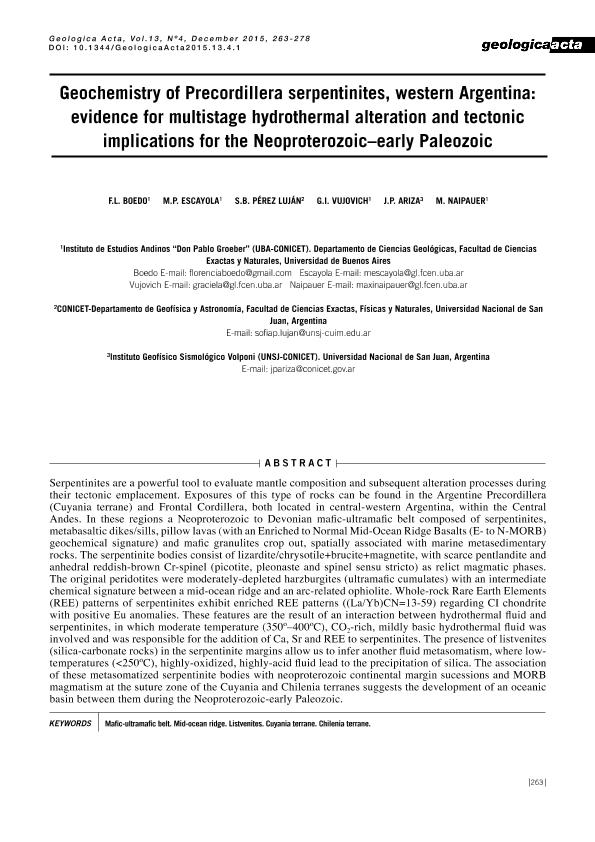Artículo
Geochemistry of precordillera serpentinites, western Argentina: Evidence for multistage hydrothermal alteration and tectonic implications for the Neoproterozoic- early Paleozoic
Boedo, Florencia Lucila ; Escayola, Monica Patricia
; Escayola, Monica Patricia ; Perez Lujan, Sofia Beatriz
; Perez Lujan, Sofia Beatriz ; Vujovich, Graciela Irene
; Vujovich, Graciela Irene ; Ariza, Juan Pablo
; Ariza, Juan Pablo ; Naipauer, Maximiliano
; Naipauer, Maximiliano
 ; Escayola, Monica Patricia
; Escayola, Monica Patricia ; Perez Lujan, Sofia Beatriz
; Perez Lujan, Sofia Beatriz ; Vujovich, Graciela Irene
; Vujovich, Graciela Irene ; Ariza, Juan Pablo
; Ariza, Juan Pablo ; Naipauer, Maximiliano
; Naipauer, Maximiliano
Fecha de publicación:
12/2015
Editorial:
Universidad de Barcelona
Revista:
Geologica Acta
ISSN:
1695-6133
Idioma:
Inglés
Tipo de recurso:
Artículo publicado
Clasificación temática:
Resumen
Serpentinites are a powerful tool to evaluate mantle composition and subsequent alteration processes during their tectonic emplacement. Exposures of this type of rocks can be found in the Argentine Precordillera (Cuyania terrane) and Frontal Cordillera, both located in central-western Argentina, within the Central Andes. In these regions a Neoproterozoic to Devonian mafic-ultramafic belt composed of serpentinites, metabasaltic dikes/sills, pillow lavas (with an Enriched to Normal Mid-Ocean Ridge Basalts (E- to N-MORB) geochemical signature) and mafic granulites crop out, spatially associated with marine metasedimentary rocks. The serpentinite bodies consist of lizardite/chrysotile+brucite+magnetite, with scarce pentlandite and anhedral reddish-brown Cr-spinel (picotite, pleonaste and spinel sensu stricto) as relict magmatic phases. The original peridotites were moderately-depleted harzburgites (ultramafic cumulates) with an intermediate chemical signature between a mid-ocean ridge and an arc-related ophiolite. Whole-rock Rare Earth Elements (REE) patterns of serpentinites exhibit enriched REE patterns ((La/Yb)CN=13-59) regarding CI chondrite with positive Eu anomalies. These features are the result of an interaction between hydrothermal fluid and serpentinites, in which moderate temperature (350º–400ºC), CO2-rich, mildly basic hydrothermal fluid was involved and was responsible for the addition of Ca, Sr and REE to serpentinites. The presence of listvenites (silica-carbonate rocks) in the serpentinite margins allow us to infer another fluid metasomatism, where lowtemperatures (<250ºC), highly-oxidized, highly-acid fluid lead to the precipitation of silica. The association of these metasomatized serpentinite bodies with neoproterozoic continental margin sucessions and MORB magmatism at the suture zone of the Cuyania and Chilenia terranes suggests the development of an oceanic basin between them during the Neoproterozoic-early Paleozoic.
Archivos asociados
Licencia
Identificadores
Colecciones
Articulos(CCT - SAN JUAN)
Articulos de CENTRO CIENTIFICO TECNOLOGICO CONICET - SAN JUAN
Articulos de CENTRO CIENTIFICO TECNOLOGICO CONICET - SAN JUAN
Articulos(CIGEOBIO)
Articulos de CENTRO DE INVESTIGACIONES DE LA GEOSFERA Y BIOSFERA
Articulos de CENTRO DE INVESTIGACIONES DE LA GEOSFERA Y BIOSFERA
Articulos(IDEAN)
Articulos de INSTITUTO DE ESTUDIOS ANDINOS "DON PABLO GROEBER"
Articulos de INSTITUTO DE ESTUDIOS ANDINOS "DON PABLO GROEBER"
Citación
Boedo, Florencia Lucila; Escayola, Monica Patricia; Perez Lujan, Sofia Beatriz; Vujovich, Graciela Irene; Ariza, Juan Pablo; et al.; Geochemistry of precordillera serpentinites, western Argentina: Evidence for multistage hydrothermal alteration and tectonic implications for the Neoproterozoic- early Paleozoic; Universidad de Barcelona; Geologica Acta; 13; 4; 12-2015; 263-278
Compartir
Altmétricas



